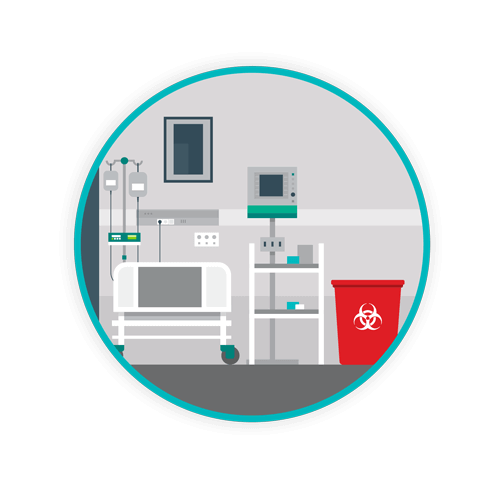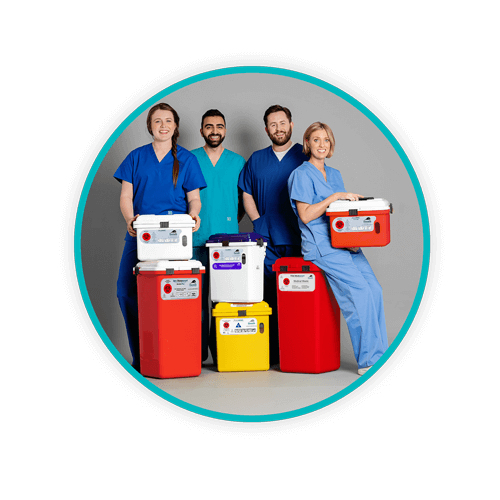The Elements Of Hospital Waste Reduction

Hospital waste reduction has become a topic of keen interest and growing concern among hospital administrators, as well as managers of medical clinics, dental practices, veterinary offices, and similar biomedical enterprises. This article reviews hospital waste reduction challenges and the best ways to overcome them.
Talk to an expert about reducing your waste
TOPICS WE WILL COVER:
1/ Introducing Hospital Waste Reduction
2/ How to Reduce Medical Waste in Hospitals
3/ Reducing Waste in Healthcare: Paper & Cardboard
4/ Reducing Waste in Healthcare: Plastic
5/ Reducing Regulated Medical Waste in Hospitals
6/ Becoming a “Greener” Hospital and Developing a Medical Waste Reduction Plan
7/ How to Reduce Healthcare Waste Through Education and Training for Staff
Introducing Hospital Waste Reduction
Hospital waste reduction is one of the most socially and financially relevant categories of waste management, which is why it’s become a topic of interest for biomedical enterprises.
Embracing the principles of reducing, reusing, and recycling in healthcare not only enhances your hospital’s external brand but also offers significant societal benefits. By implementing programs focused on reducing medical waste and promoting sustainability, hospitals can demonstrate responsible management.
From a fiscal standpoint, reducing medical waste can significantly lower operational costs. Additionally, recycling helps recover costs from spent resources, further reducing the financial burden of disposal.
You should also keep in mind that hospital waste reduction is under the scrutiny of at least three federal agencies—OSHA, the DOT, and the CDC—not to mention a raft of state & local entities. It’s crucial to get expert advice before designing a hospital waste reduction program.
How To Reduce Medical Waste in Hospitals
A logical way to reduce hospital waste outflow is to control material inflow as much as possible. This requires understanding what you buy, how you use it, and what amount of it you typically dispose of; and adjusting your ordering practices to eliminate consequent waste in health care.
For example, you could purchase cleaning materials & equipment in specific quantities across departments to avoid overbuying; or using washable cups, plates, glasses, pitchers, and utensils instead of disposable ones.
Hospital Waste Audits
Audits are an essential part of the tool kit in understanding the quantity and type of waste amassed, and where it is being disposed of. An audit can provide specialized department-level (rather than facility-level) information, which allows for greater analysis and hospital waste reduction.
For example, you might audit surgical packs to determine if any items aren’t used frequently enough for inclusion in each and every one of them.
Reducing Waste in Healthcare: Paper & Cardboard

The World Health Organization estimates that 85% of hospital waste is of the general variety, more than half of which is paper & cardboard (54%). Fortunately, much of this paper & cardboard waste can be reduced by common-sense initiatives for “reducing, reusing, and recycling.”
Here are some examples:
- On the clinical side, using washable linens, diapers, and surgical/nursing gowns instead of paper ones.
- Administratively, using both sides of paper; encouraging email & messaging in lieu of paper-and-pencil correspondence; subscribing to online publications instead of their paper counterparts; and keeping recycling bins handy.
- As to cleaning & maintenance, sorting cardboard, office paper, and newspapers for recycling; and using electronic hand-dryers in lieu of paper towels.
- Regarding food service, using washable cups, plates, and glasses rather than the paper kind.
As to cardboard specifically, using reusable medical waste containers can drive down cardboard waste volumes. You can also significantly reduce waste by arranging for suppliers to replace cardboard containers with reusable (plastic or metal) ones that can be backhauled; and purchasing in bulk rather than in small, individual packages.
Reducing Waste in Healthcare: Plastic
One of the best ways to drive down plastic waste volumes is by using reusable medical waste containers. instead of those made with single-use plastics.
Beyond that, one of the challenges of recycling plastics is that typically, an individual hospital doesn’t produce enough recyclable plastic by itself to capture the interest of a local plastics recycler.
One solution is for area hospitals to pool their recyclable plastics in order to achieve a critical mass. Another more feasible option is to focus on recycling plastic wastes that are valuable to recyclers and are generated in the largest quantities.
For example: 
- Sterilization wrap—aka “blue wrap,” which is made of non-woven polypropylene
- Polypropylene irrigation bottles
- Rigid plastic trays, basins, and containers made of PET, PETG, PS, or HDPE)
- Shrink wrap, stretch film, and plastic bags (PE) (Large quantities at incoming dock areas can be easily recycled.
Experts in reducing medical waste suggest starting small. For example, implementing a mixed-plastics recycling initiative only in one hospital area or a limited number of rooms, and then expanding it to other locations.
One tactic is to begin by selecting a high-impact area (e.g. an operating room), noting what plastics can be easily collected and recycled, and then implementing a pilot program there. Another is to begin with a hospital area that generates a lot of recyclable plastics, preferably one where the staff have shown adequate commitment to recycling. E.g., smaller areas with repetitive low-pressure activities, clean or sterile spaces, and a consistent group of staff.
Some likely candidates are sterile areas in catheter labs, interventional radiology rooms, and both ambulatory & primary surgery departments. Also consider clean areas in pharmacies, anaesthesia rooms, and prep locations.
Reducing Regulated Medical Waste in Hospitals

The incorrect disposal of general waste items into biohazardous waste containers is a common, yet preventable source of excess regulated medical waste (RMW). The incorrect categorization of medical waste unnecessarily inflates the amount of waste destined to be treated as hazardous. This leads to escalating costs without offering environmental or financial benefits.
You can tackle this issue by limiting the placement of RMW (Regulated Medical Waste) containers to hospital rooms and areas where RMW typically exists or is generated. Ensure these containers are clearly labeled and correctly color-coded for easy identification.
Examples of Hospital Waste Reduction Strategies
- Using reusable containers for sharps, pharmaceutical, medical, and chemotherapy waste streams
- Engaging medical waste management partners who can help educate your staff, perform waste audits, and improve efficiencies
- Using smaller RMW containers in patient rooms makes it more difficult and thereby less likely that patients or staff will use them as trash bins
- Where practical, making RMW containers accessible only to staff, as patients are much more likely to place waste in the wrong receptacle than staff
- Not placing RMW containers side-by-side with general waste containers, as doing so makes it too easy to drop waste into the wrong container.
Becoming a “Greener” Hospital and Developing a Medical Waste Reduction Plan
It’s well worth developing a formal hospital-wide, waste-management plan that articulates your goals, establishes procedures, and educates your staff about them. A waste plan is crucial for creating a more sustainable program within healthcare facilities, helping reduce overall waste volumes and environmental impacts.
The hospital waste reduction plan should include waste audits and periodic spot-checks to assess whether paper, plastics, cardboard, and RMW are being properly disposed of. The findings should be shared with staff, and retraining should be provided where deficiencies in healthcare waste management are discovered.
Your plan’s policies & procedures for reducing medical waste should be reviewed annually, and all staff should know that following your plan isn’t an option—it’s a requirement.
How To Reduce Healthcare Waste Through Education and Training for Staff
With correct segregation, Regulated Medical Waste (RMW) should only make up approximately 10% of a facility’s waste. However, it often amounts to 50% of total waste volume, highlighting the lack of knowledge about proper segregation and reducing medical waste.
By providing comprehensive education and training to health workers, you can significantly lower costs and save on time and labor. As your partner in hospital waste reduction, Daniels Health offers expert training for both clinical and non-clinical staff in each facility we collaborate with. This includes e-learning courses and educational materials like posters and placards for disposal points.
Reduce Medical Waste with the Experts at Daniels Health
Daniels offers 30+ years of unparalleled experience advising hospitals, medical clinics, dental practices, veterinary offices, and similar biomedical enterprises about the safe & legal management of their various waste streams. Our composite solutions, products, services, training, treatment, and processing have helped biomedical professionals achieve the highest standards of sustainability—worldwide.
Daniels can help you develop a plan that considers the many regulatory complexities governing hospital waste reduction—one that always meets federal, state, and local regulations.
Don’t do it alone – get in touch about hospital waste reduction, recycling plans; optimization of RMW collection schedules; and more.
Let's Talk!
Your time is valuable, and we don’t want to play hard to get. You can either phone us directly on the details listed on our contact page, or feel free to fill out this short form and one of our team members will get back to you as quickly as possible.
